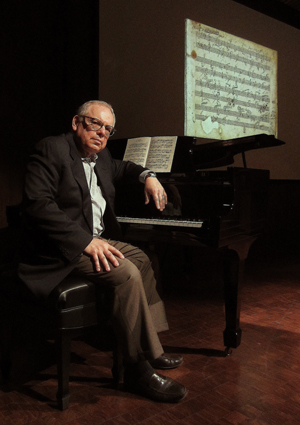by Guytano Parks

Tuesday morning’s Competition Conversation, the fourth CIPC “Festival Event” held in the Recital Hall at The Cleveland Museum of Art was entitled “The Art of Performing Beethoven’s Piano Sonatas”. Featured speaker Peter Takács, Professor of Piano at Oberlin College Conservatory of Music, knows his subject intimately as he conquered the mountain as well, having recorded the entire cycle of Beethoven’s 32 piano sonatas on the CAMBRIA label.
He began his presentation by showing projections of Beethoven’s original manuscripts of pages from various sonatas, telling of profound and unforgettable visits to study them in Beethoven’s house in Bonn, Germany where they are securely stored in a vault. Topics which were touched upon (a week would barely have been enough time to cover everything!) were Background, Sources, Tempo, Structure, Historical Instruments, Technical Issues and Affect and Character.
Takács interestingly and fittingly spoke of Beethoven’s writing as being “orchestral or like that of a string quartet,” playing excerpts on the piano while calling out his imagined instrumentation. He played a recorded arrangement of his orchestration of the Lebewohl sonata, illustrating the opening “horn call” followed by a “string quartet” to explain how the pianist “must have a sense of color and texture and think in orchestral terms when performing this music.” The Pathétique sonata was also chosen to serve as an example.
Takács discussed various editions of the sonatas, placing particular interest and trust in the volume by Carl Czerny, Beethoven’s student and friend. And Beethoven’s publishers made sure to get it right as they were subject to his demanding, boorish manner, hence the accuracy of the first editions. Takács also discussed the issue of Beethoven’s piano having fewer keys than the modern piano’s keyboard of eighty-eight. Writing of extreme upper treble melodies and extreme lower bass passages “were undoubtedly truncated due to the fact that those notes (keys) were not on Beethoven’s instrument. Do we play what we assume he intended (comparing to how the melody was treated in parallel passages in different registers or tonalities), or do we play what’s written and regard it as gospel?” This has been a puzzler for two centuries!
The invention of the metronome delighted Beethoven and he went back to his scores, meticulously and obsessively adding metronome markings to virtually everything. Takács projected an excerpt from the writings of Beethoven where he says of one of his metronome markings, “…but this can apply only to the first measures, because feeling also has its tempo.” Beethoven realized that the metronome was too mechanical and that it can only be used as a general guide, as differences of character within the same tempo in a given movement must sound and feel appropriate. As he gradually became deaf, he relied on the sight of the pendulum movement rather than the sound of the clicks.
In addition to solutions to octave glissandi, extended trills with a top note melody played by the same hand (Waldstein sonata) and una corda pedal usage and effects, Takács also discussed Beethoven’s sosenuto pedal indications. We all know that modern-day pianos have an incredible sustaining ability as opposed to the fast decay of sound on the fortepianos of Beethoven’s time. This renders many of Beethoven’s pedal markings to be obsolete and they must be “taken with a grain of salt.” Obviously, holding the pedal down during the entire duration of the first movement of the Moonlight sonata on our wonderful modern instruments of today would be produce a ludicrous, messy blur.
Pointing out Beethoven’s genius in variation writing, Takács told an amusing story of the creation of the Diabelli Variations: “Mr. Diabelli sent his theme to fifty different composers who each wrote only one variation. Beethoven received the theme as well, but thought it to be extremely trite and uninteresting. Nonetheless, he composed a set of thirty-three variations upon that simplistic theme which subsequently went on to become the Diabelli Variations, considered by many to be his greatest composition for piano.”
The time passed quickly, as it seemed to do for all of the other Competition Conversations in this CIPC Festival. Professor Takács could easily have spent an hour or more on each movement of all 32 piano sonatas, delighting us with his deep love and enthusiasm for Beethoven’s creations; in 2013, we’re still fascinated and captivated.
Photo by Guytano Parks.
Published on ClevelandClassical.com August 7, 2013
Click here for a printable version of this article.



